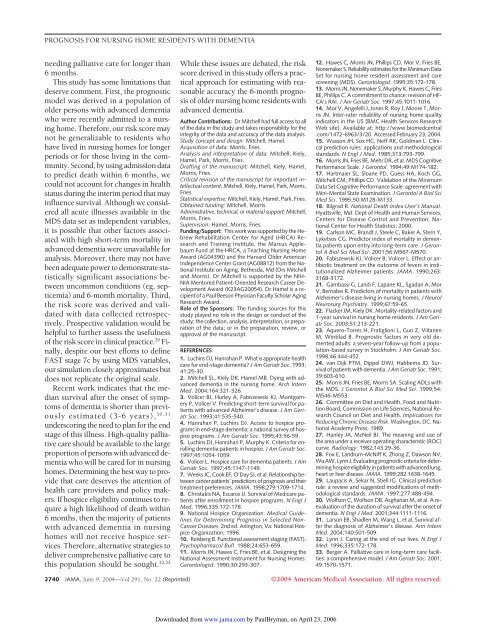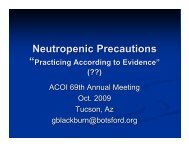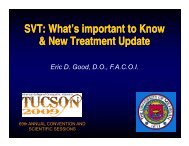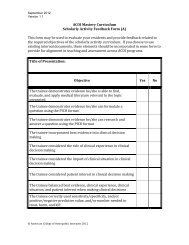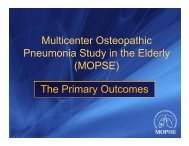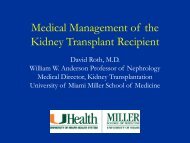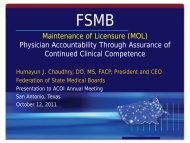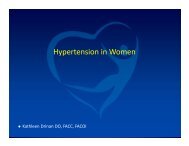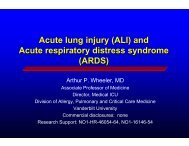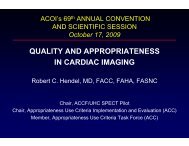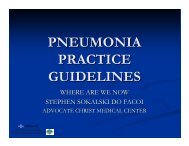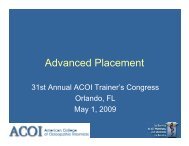Estimating Prognosis for Nursing Home Residents With Advanced ...
Estimating Prognosis for Nursing Home Residents With Advanced ...
Estimating Prognosis for Nursing Home Residents With Advanced ...
Create successful ePaper yourself
Turn your PDF publications into a flip-book with our unique Google optimized e-Paper software.
PROGNOSIS FOR NURSING HOME RESIDENTS WITH DEMENTIAneeding palliative care <strong>for</strong> longer than6 months.This study has some limitations thatdeserve comment. First, the prognosticmodel was derived in a population ofolder persons with advanced dementiawho were recently admitted to a nursinghome. There<strong>for</strong>e, our risk score maynot be generalizable to residents whohave lived in nursing homes <strong>for</strong> longerperiods or <strong>for</strong> those living in the community.Second, by using admission datato predict death within 6 months, wecould not account <strong>for</strong> changes in healthstatus during the interim period that mayinfluence survival. Although we consideredall acute illnesses available in theMDS data set as independent variables,it is possible that other factors associatedwith high short-term mortality inadvanced dementia were unavailable <strong>for</strong>analysis. Moreover, there may not havebeen adequate power to demonstrate statisticallysignificant associations betweenuncommon conditions (eg, septicemia)and 6-month mortality. Third,the risk score was derived and validatedwith data collected retrospectively.Prospective validation would behelpful to further assess the usefulnessof the risk score in clinical practice. 29 Finally,despite our best ef<strong>for</strong>ts to defineFAST stage 7c by using MDS variables,our simulation closely approximates butdoes not replicate the original scale.Recent work indicates that the mediansurvival after the onset of symptomsof dementia is shorter than previouslyestimated (3-6 years), 30,31underscoring the need to plan <strong>for</strong> the endstage of this illness. High-quality palliativecare should be available to the largeproportion of persons with advanced dementiawho will be cared <strong>for</strong> in nursinghomes. Determining the best way to providethat care deserves the attention ofhealth care providers and policy makers.If hospice eligibility continues to requirea high likelihood of death within6 months, then the majority of patientswith advanced dementia in nursinghomes will not receive hospice services.There<strong>for</strong>e, alternative strategies todeliver comprehensive palliative care tothis population should be sought. 32,33While these issues are debated, the riskscore derived in this study offers a practicalapproach <strong>for</strong> estimating with reasonableaccuracy the 6-month prognosisof older nursing home residents withadvanced dementia.Author Contributions: Dr Mitchell had full access to allof the data in the study and takes responsibility <strong>for</strong> theintegrity of the data and accuracy of the data analysis.Study concept and design: Mitchell, Hamel.Acquisition of data: Morris, Fries.Analysis and interpretation of data: Mitchell, Kiely,Hamel, Park, Morris, Fries.Drafting of the manuscript: Mitchell, Kiely, Hamel,Morris, Fries.Critical revision of the manuscript <strong>for</strong> important intellectualcontent: Mitchell, Kiely, Hamel, Park, Morris,Fries.Statistical expertise: Mitchell, Kiely, Hamel, Park, Fries.Obtained funding: Mitchell, Morris.Administrative, technical, or material support: Mitchell,Morris, Fries.Supervision: Hamel, Morris, Fries.Funding/Support: This work was supported by the HebrewRehabilitation Center <strong>for</strong> Aged (HRCA) Researchand Training Institute, the Marcus ApplebaumFund at the HRCA, a Teaching <strong>Nursing</strong> <strong>Home</strong>Award (AG04390) and the Harvard Older AmericanIndependence Center Grant (AG08812) from the NationalInstitute on Aging, Bethesda, Md (Drs Mitchelland Morris). Dr Mitchell is supported by the NIH-NIA Mentored Patient-Oriented Research Career DevelopmentAward (K23AG20054). Dr Hamel is a recipientof a Paul Beeson Physician Faculty Scholar AgingResearch Award.Role of the Sponsors: The funding sources <strong>for</strong> thisstudy played no role in the design or conduct of thestudy; the collection, analysis, interpretation, or preparationof the data; or in the preparation, review, orapproval of the manuscript.REFERENCES1. Luchins DJ, Hanrahan P. What is appropriate healthcare <strong>for</strong> end-stage dementia? J Am Geriatr Soc. 1993;41:25-30.2. Mitchell SL, Kiely DK, Hamel MB. Dying with advanceddementia in the nursing home. Arch InternMed. 2004;164:321-326.3. Volicer BJ, Hurley A, Fabiszewski KJ, MontgomeryP, Volicer V. Predicting short-term survival <strong>for</strong> patientswith advanced Alzheimer’s disease. JAmGeriatrSoc. 1993;41:535-540.4. Hanrahan P, Luchins DJ. Access to hospice programsin end-stage dementia: a national survey of hospiceprograms. J Am Geriatr Soc. 1995;43:56-59.5. Luchins DJ, Hanrahan P, Murphy K. Criteria <strong>for</strong> enrollingdementia patients in hospice. J Am Geriatr Soc.1997;45:1054-1059.6. Volicer L. Hospice care <strong>for</strong> dementia patients. JAmGeriatr Soc. 1997;45:1147-1149.7. Weeks JC, Cook EF, O’Day SJ, et al. Relationship betweencancer patients’ predictions of prognosis and theirtreatment preferences. JAMA. 1998;279:1709-1714.8. Christakis NA, Escarce JJ. Survival of Medicare patientsafter enrollment in hospice programs. N Engl JMed. 1996;335:172-178.9. National Hospice Organization. Medical Guidelines<strong>for</strong> Determining <strong>Prognosis</strong> in Selected Non-Cancer Diseases. 2nd ed. Arlington, Va: National HospiceOrganization; 1996.10. Reisberg B. Functional assessment staging (FAST).Psychopharmacol Bull. 1988;24:653-659.11. Morris JN, Hawes C, Fries BE, et al. Designing theNational Assessment Instrument <strong>for</strong> <strong>Nursing</strong> <strong>Home</strong>s.Gerontologist. 1990;30:293-307.12. Hawes C, Morris JN, Phillips CD, Mor V, Fries BE,Nonemaker S. Reliability estimates <strong>for</strong> the Minimum DataSet <strong>for</strong> nursing home resident assessment and carescreening (MDS). Gerontologist. 1995;35:172-178.13. Morris JN, Nonemaker S, Murphy K, Hawes C, FriesBE, Phillips C. A commitment to chance: revision of HF-CA’s RAI. J Am Geriatr Soc. 1997;45:1011-1016.14. Mor V, Angelelli J, Jones R, Roy J, Moore T, MorrisJN. Inter-rater reliability of nursing home qualityindicators in the US [BMC Health Services ResearchWeb site]. Available at: http://www.biomedcentral.com/1472-6963/3/20. Accessed February 23, 2004.15. Wasson JH, Sox HC, Neff RK, Goldman L. Clinicalprediction rules: applications and methodologicalstandards. N Engl J Med. 1985;313:793-799.16. Morris JN, Fries BE, Mehr DR, et al. MDS CognitivePer<strong>for</strong>mance Scale. J Gerontol. 1994;49:M174-182.17. Hartmaier SL, Sloane PD, Guess HA, Koch GG,Mitchell CM, Phillips CD. Validation of the MinimumData Set Cognitive Per<strong>for</strong>mance Scale: agreement withMini-Mental State Examination. J Gerontol A Biol SciMed Sci. 1995;50:M128-M133.18. Bilgrad R. National Death Index User’s Manual.Hyattsville, Md: Dept of Health and Human Services,Centers <strong>for</strong> Disease Control and Prevention, NationalCenter <strong>for</strong> Health Statistics; 2000.19. Carlson MC, Brandt J, Steele C, Baker A, Stern Y,Lyketsos CG. Predictor index of mortality in dementiapatients upon entry into long-term care. J GerontolA Biol Sci Med Sci. 2001;56:M567-M570.20. Fabiszewski KJ, Volicer B, Volicer L. Effect or antibiotictreatment on the outcome of fevers in institutionalizedAlzheimer patients. JAMA. 1990;263:3168-3172.21. Gambassi G, Landi F, Lapane KL, Sgadari A, MorV, Bernabei R. Predictors of mortality in patients withAlzheimer’s disease living in nursing homes. J NeurolNeurosurg Psychiatry. 1999;67:59-65.22. Flacker JM, Kiely DK. Mortality-related factors and1-year survival in nursing home residents. JAmGeriatrSoc. 2003;51:213-221.23. Aquero-Torres H, Fratiglioni L, Guo Z, ViitanenM, Winblad B. Prognostic factors in very old dementedadults: a seven-year follow-up from a population-basedsurvey in Stockholm. J Am Geriatr Soc.1998;46:444-452.24. van Dijk PTM, Dippel DWJ, Habbema JD. Survivalof patients with dementia. J Am Geriatr Soc. 1991;39:603-610.25. Morris JN, Fries BE, Morris SA. Scaling ADLs withthe MDS. J Gerontol A Biol Sci Med Sci. 1999;54:M546-M553.26. Committee on Diet and Health, Food and NutritionBoard, Commission on Life Sciences, National ResearchCouncil on Diet and Health. Implications <strong>for</strong>Reducing Chronic Disease Risk. Washington, DC: NationalAcademy Press; 1989.27. Hanley JA, McNeil BJ. The meaning and use ofthe area under a receiver operating characteristic (ROC)curve. Radiology. 1982;143:29-36.28. Fox E, Landrum-McNiff K, Zhong Z, Dawson NV,Wu AW, Lynn J. Evaluating prognostic criteria <strong>for</strong> determininghospice eligibility in patients with advanced lung,heart or liver disease. JAMA. 1999;282:1638-1645.29. Laupacis A, Sekar N, Stiell IG. Clinical predictionrule: a review and suggested modifications of methodologicalstandards. JAMA. 1997;277:488-494.30. Wolfson C, Wolfson DB, Asgharian M, et al. A reevaluationof the duration of survival after the onset ofdementia. N Engl J Med. 2001;344:1111-1116.31. Larson EB, Shadlen M, Wang L, et al. Survival afterthe diagnosis of Alzheimer’s disease. Ann InternMed. 2004;140:501-509.32. Lynn J. Caring at the end of our lives. N Engl JMed. 1996;335:172-178.33. Berger A. Palliative care in long-term care facilities:a comprehensive model. J Am Geriatr Soc. 2001;49:1570-1571.2740 JAMA, June 9, 2004—Vol 291, No. 22 (Reprinted) ©2004 American Medical Association. All rights reserved.Downloaded from www.jama.com by PaulBryman, on April 23, 2006


